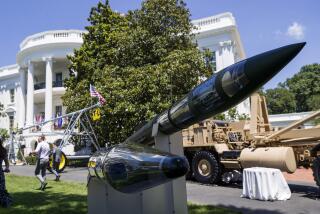All 2.1 Million in Military Service to Get AIDS Tests : Victims Won’t Be Discharged
- Share via
WASHINGTON — The Defense Department, in a major response to the growing problem of AIDS, has decided to test all 2.1 million U.S. military personnel for the disease, a Pentagon official said today.
Those found to have acquired immune deficiency syndrome--which strips the body of its natural defense against diseases--will be treated but will not be forced to resign from the military, the official told reporters.
Instead, they will be placed on a limited service status that has yet to be defined, the official said.
A formal announcement of the program, approved late Thursday by Defense Secretary Caspar W. Weinberger and the secretaries of the Army, Navy and Air Force, will be made soon, the official said.
He said it has not been decided how soon testing would begin.
Not Hysterical Reaction
“There is no hysterical overreaction here,” said the official, who spoke on condition of anonymity. “We are dealing with a new disease and we want to be successful in doing so.”
Fear of AIDS, which is known to be transmitted by sexual contact and blood transfusions, prompted the Pentagon to announce on Aug. 30 that it would begin testing all volunteers for the armed services.
There already have been reports of positive readings from preliminary AIDS blood tests given to Marine Corps and Air Force recruits.
The new, expanded decision to test all men and women in the armed forces will required a major and costly program involving the aid of private laboratories.
More Organized Group
“Because it (the Defense Department) is an organized body which can test people and have results, it’s probably ahead of the general population in what it’s doing in research and care at this point,” the official said.
“Although it’s a serious disease, we’re talking about something that does not affect most of the military population.”
Preliminary plans call for each military man and woman and each prospective recruit to undergo a $3 blood test known as ELISA, a preliminary search for the HLTV-III virus--a common tip-off that a person has been exposed to AIDS. However, the test has a high error rate, so personnel with positive readings would be tested again and perhaps three times.
Another Examination
Those who repeatedly fail this test would undergo a “Western Blot” examination, which is a more accurate determiner of the presence of AIDS virus. Those still showing a positive reading would then be given a clinical physical exam, which usually consists of a skin test and cell work done in a hospital.
Given the military’s fighting mission, “we would err on the side of conservatism” in deciding what to do with soldiers who are only suspected of having the disease, the official said.
Researchers reported Thursday that contrary to what had been thought, the first victims of the AIDS epidemic in the United States were intravenous drug users and not homosexuals.
More to Read
Sign up for Essential California
The most important California stories and recommendations in your inbox every morning.
You may occasionally receive promotional content from the Los Angeles Times.









